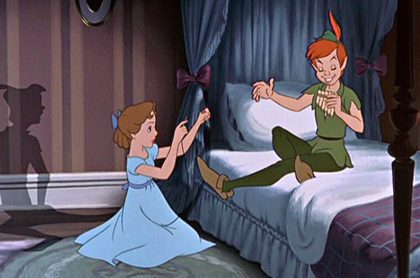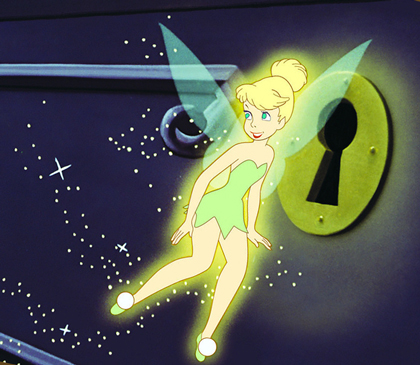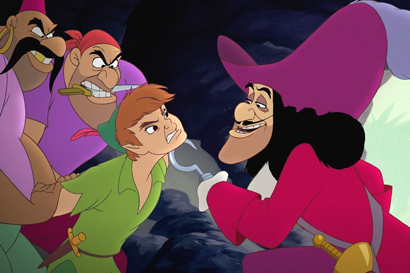
 |
|
|
|
While you're waiting in line to see Escape from Tomorrow, it's not a bad idea to reflect on all the marvels and wonders that Walt Disney has given us. The monolithic Ministry of Disney may oversell the idea that everything it produces is great art for the culture, but the fact remains that we indeed wouldn't want to do without a lot of Walt's wonderful creations. Those of us old enough to remember a less commercial era can still get a warm glow when contemplating how wonderful a trip to Disneyland could be, and how any new Disney movie was a surefire ticket to a heightened entertainment experience. 1953's Peter Pan sees the Disney animators doing what they do best, stunning us with a fun interpretation of a classic. Disney had to buy rights for the property, which gestated for over a decade before emerging as perhaps the best of his '50s animated films. Although not quite in the artistic league of his '40s masterpieces, Peter Pan delivers fun characters, action, adventure and comedy... not to mention a thick slice of insights about gender development and sexual impulses. 
James M. Barrie's play is ripe with ideas about the nature of childhood, imagination, and the path toward maturity. In the Edwardian Darling household, Mr. Darling (voice: Hans Conried) wants his daughter Wendy (v: Kathryn Beaumont) to stop dreaming of fairy tales and become an adult. She is instead visited by her favorite fantasy figure Peter Pan (v: Bobby Driscoll, although I always think of Russ Tamblyn) and his fairy sprite Tinker Bell, who is jealous of Pan's interest in Wendy. Pan shows Wendy and her two younger brothers Michael and John (voices Tommy Luske & Paul Collins) how to fly, and the quintet swoops over London to Never Never Land, following the first star to the right, straight on 'til morning. On the magical island Never Never Land Wendy becomes a substitute mother for Pan's "Lost Boys", a group of moppets that exist to have fun morning until night. They play games with the local "Injun" tribe and hide out from the dreaded pirate Captain Hook (v: Hans Conried), who is determined to slay Pan. Hook has a goofy sidekick, Smee (v: Bill Thompson) and is pursued by a comical crocodile, whose approach is signaled by the tick of an alarm clock it has swallowed. Hook kidnaps the Indian Princess Tiger Lily (v: June Foray) to turn the Chief against the Lost Boys, and uses Tinker Bell's jealousy of Wendy to learn the location of Pan's hideout. You may hear people rag on Peter Pan for its non-PC attitudes, but don't listen to them. True enough, the dated "Injuns" aren't going to fly in a Native American studies class, and our heroine Wendy doesn't qualify for liberated status. But Pan expresses everything marvelous about infantile game playing, make-pretend adventure fun and just plain no-parents-are-around-we-can-do-anything-we-want emancipation. Pan's Lost Boys dress in animal-like costumes that remind us of the later monsters of Where the Wild Things Are. It makes perfect sense, as these kids are indulging all of their pre-sexual urges. Raising hell with the Indians is a blast, especially if the winners let the losers go at the end of the game. Never Never Land is a place for 'safe' play anarchy, like Disneyland's original Tom Sawyer's Island. Peter Pan has a lot to say about gender development. Wendy remains a lady at all times, but she's "terribly fond" of Pan and expresses her interest in him by providing a bit of feminine, motherly common sense. Wendy mothers her younger brothers, sharing that role (rather weirdly) with the family dog. Instead of eagerly ditching that role in Never Never Land, she volunteers to mother Pan's ragged Lost Boys as well. The world seems organized to make things easier for young rakes like Peter Pan. The trip into the imagination means taking flight, and whether accomplished with pixie dust or by positive thinking, the ability to fly is definitely sensual. Flying through the clouds above London, the Darling children live a key dream experience: freedom, exhilaration, danger. Do kids in the audience still cry when the Darling's tethered dog can't follow? We did when we were tots. It's like the Rapture has happened, and the pooch missed the bus. 
It would be dumb to make the case that everything that happens in Never Never Land is some kind of coded sex experience. Adventure is dangerous and forbidden too, and that's the kind of fun the Lost Boys are after. They don't spend their days checking out the naked mermaids, after all. But even though nobody's quite ready for that step, Disney has packed Never Never Land with sublimated adult delights. Our older hero in the green Robin Hood suit, the one that has a syndrome named after him, is date bait for Wendy, the nubile mermaids, and Princess Tiger Lily (whose dance reminds us not a little of Red Hot Riding Hood). And face it, Tinker Bell is basically a bug in the shape of Marilyn Monroe, complete with a highly developed sense of feminine possessiveness insofar as Peter is concerned. Tinker Bell is a sexy doll with wings, who (now) reminds us of other miniaturized "pocket edition" sex fantasies ... you know, the portable living Barbie that's impractical but fascinating, like a miniature railway set. Did Tinker Bell inspire artist LeRoy Neiman to create the "Femlin" homunculus for Hugh Hefner's magazine Playboy? And let's get the P.C. elements out of the way at the same time. These are the dream fantasies of sheltered English school-kids from the 1890s, remember. Never Never Land's mermaids slink about on the rocks, dreaming of being 'better friends' with Peter. That's what they do. The island map also shows a place called 'Cannibal Cove'. It's good that Disney passed that over, or Peter Pan might have ended up like Song of the South. The Injun tribe may be almost as demeaning, but it's pure adolescent fun. The braves are given a great song. Its leader has an amusing voice and young Tiger Lily is so enticing that even Wendy becomes jealous. The film's romantic tension is all expressed as girl-on-girl jealousy. Wendy would definitely like a kiss, but she wouldn't think of doing anything more forward with her dream boy. Peter seems perfectly asexual as he is, and Wendy is on a "pre-growing up" adventure. Perhaps Never Never Land is for girls a dream of innocent romance that they intuit will be difficult to find among the rude 'n' crude real-life boys they'll have to fend off back home. About the most intimate service Wendy provides for Peter, is sewing his shadow back on (top image above). I have no knee-jerk interpretation to offer for that one. The big conflict from the play is of course the warfare between Pan and that dastard Captain Hook, a purebred villain who turns into a coward whenever he hears the ticking of filmdom's most jovial crocodile. Kids adore the crocodile, as he's so tickled by his life's work pursuing Hook. I remember being scared (at age 4) of the crocodile for less than a minute, and from then on thought he was the funniest thing I'd ever seen. The cheering of the other kids probably did the trick. Hans Conried captures the character's theatrical vanity and pomposity to a "T", with the result that we like Hook even when he murders members of his own crew (off-screen). We respond to the excellent animation of various skirmishes and sword fights, with innumerable sight gags patterned after old pirate pictures. Like the "Injuns", Never Never Land's animal population is formidable-looking but friendly. A great gag has a ferocious bear suddenly distracted by a Teddy Bear toy. With the exception of Hook, everything on this magic isle is exciting but harmless. Interestingly, the alluringly cute Tinker Bell is almost as troublesome as the pirates. Not being human, she'd be happy to see Wendy fall to her death or get murdered by animals or Hook. She never learns her lesson, either. Just as in real life, if you're drawn to something really irresistible, you have to take the danger that comes with it. Watch out for blonde pixies, as they'll break your heart every time. Author Barrie's play hasn't dated because it promotes the wistful dream that everyone harbors forgotten childhood 'Peter Pan' experiences. Mr. Darling is a somewhat depressingly domesticated drone, fussing about while his missus remains cool-headed. Even Wendy interrupts his nervous blather. Wendy's brothers dream of Pan, and their adventure might as well remain a dream. Wendy is on the cusp of adult consciousness, and chooses to believe her own dreams in a more self-aware manner. But the key comes when Mr. Darling is inspired by the sight of the pirate ship 'flying' across the face of the moon. He suddenly remembers his own forgotten childhood adventures with Peter Pan. Are the sails just the spots on the moon's surface? It's a fine visual construction. 
I suppose one can say that Peter Pan functions on multiple levels, which is a semantic dodge that allows a disorganized reviewer to poke around for 'hidden meanings'. I believe that Disney's Pan is one of his most entertaining shows for young boys whose childhoods have not yet been destroyed by violent video games & smutty TV & web attractions. But it's also clear that Disney's storytellers, designers and animators have stacked Pan with really interesting semi-adult content. Old conservative Disney infused his animation entertainments with a rich line of pre-sexual imagery and situations -- in a great adventure perfectly suitable for all but the tiniest tots. Walt Disney Studios Home Entertainment's 3-Disc Diamond Edition Blu-ray of Peter Pan is a pleasing HD presentation at Disney's high quality standard. As with other Diamond Edition animation releases, a few new HD features are accompanied by a backlog of fine documentaries and featurettes from earlier DVD editions. As the creation backstories for Disney films are always interesting, most of these featurettes make for very good viewing. One new wrinkle is called the Disney Intermission. Whenever pause is pushed, a short featurette plays. I can see this being useful during interruptions for telephone calls, etc. Also new are a deleted scene and an alternate ending, both billed as never-before-seen. A number of years ago I printed a reader email incensed about Disney's re-coloring Peter Pan for a 2008 Platinum Edition DVD. The author made a compelling case that Disney had shifted a number of color values, perhaps to make Peter Pan a more comfortable visual fit with its new "Disney Princesses" branded line. I can now compare the new HD transfer with an older 2002 DVD. I still agree with friends that complain that the studio's thorough re-coloring and digital re-dos of their classic cartoons can conceivably rob them of their old organic film appearance. But I've yet to see a disc that does real harm to the 'classics'. My comparison (done today) of Peter Pan DVD 2002 and Peter Pan BD 2013 comes down on the side of the new restoration. I'd based my own previous grousing on the appearance of the color in older transfers of Peter Pan trailers, where some images are greener and darker. That and some screen grabs of the "Injun" sequence, where the sky has been changed radically from green to goldenrod. The problem with my earlier opinion is that it assumes that the color timing on the trailer reflects the original feature colors, when the trailer was surely timed as a separate unit. And we're told that the fussy Disney techs referred to original animation cels for the newest restoration. The goldenrod sky in the "Injun" sequence looks plenty attractive. Moreover, a fair comparison is difficult because the 2002 DVD looks dull, soft and murky compared to the new Blu-ray. The encoding doesn't reproduce line art as well as it should, whereas on the Blu-ray we can see where a shot has taken a smaller area of an animation cel -- lines are thicker and we can even see a hint of the 'stacked cel' effect. The new Blu-ray shows more detail --even more animation artifacts -- than the older disc. As an example of a flaw (if it can be called that) that is not corrected in the Blu-ray, watch the tilt-up shot reveal of the pirate ship against the moon in the last scene. A bit of cloud to the right of the moon 'pops' into position. If the Disney suits wanted to clean up every dimple and missed stitch in the movie, it would have been easy to 'fix' the shot. But we're seeing it as it always was. The second DVD disc contains only an introduction and a Tinker Bell featurette as extras. Instructions and a code are included to download a full digital copy of the film. And I learned something writing this review notice -- the correct spelling of Tinker Bell. You know the effect sexy bug-pixies have on mature boys -- we can't even keep their names straight.
On a scale of Excellent, Good, Fair, and Poor,
Peter Pan Blu-ray rates:
Reviews on the Savant main site have additional credits information and are often updated and annotated with reader input and graphics. Also, don't forget the 2011 Savant Wish List. T'was Ever Thus.
Review Staff | About DVD Talk | Newsletter Subscribe | Join DVD Talk Forum |
| ||||||||||||||||||